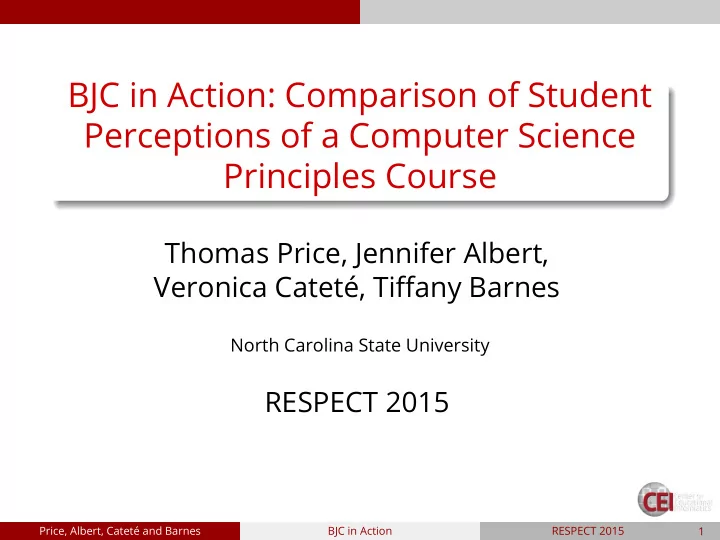

BJC in Action: Comparison of Student Perceptions of a Computer Science Principles Course Thomas Price, Jennifer Albert, Veronica Cateté, Tiffany Barnes North Carolina State University RESPECT 2015 Price, Albert, Cateté and Barnes BJC in Action RESPECT 2015 1
Background BJC Course Description ● BJC uses the Snap visual programming language to introduce students to programming concepts ● BJC is centered on 7 Big Ideas: Creativity, Abstraction, ○ Algorithms, Programming, Big Data, the Internet and Social Impacts ● Students build computing artifacts to show impacts of computing (web pages, apps, games, etc.) Price, Albert, Cateté and Barnes BJC in Action RESPECT 2015 2
Background Motivation ~300,000 students in AP Calculus AB in 2014 49% female; 24% minority students <40,000 students in AP Computer Science in 2014 20% female; 22% minority students Initiatives to broaden participation in computing include development of Exploring Computer Science course and AP CS Principles (CSP). The Beauty and Joy of Computing (BJC) is a CSP curriculum How well does this curriculum meet the needs of students from underrepresented groups? Price, Albert, Cateté and Barnes BJC in Action RESPECT 2015 3
Method Research Question For high school students in a BJC course, do females or minority students: ● Have different backgrounds coming in? ● Have different experiences during the course? ● Have different outcomes from the course? Price, Albert, Cateté and Barnes BJC in Action RESPECT 2015 4
Method Sample ● 399 post-course surveys from BJC students ● 19 classrooms where teachers had undergone BJC PD the previous summer Price, Albert, Cateté and Barnes BJC in Action RESPECT 2015 5
Results Prior Experience ● Fewer minority students had access to a computer at home (87.5% vs 96.8%; p =0.001) No difference in smartphone or tablet access ○ ● More female students had access to a tablet at home (60.2% vs 44.7%; p =0.013) Both findings significant when controlling for classroom ○ ● Minority students had taken more CS courses ( p =0.006) ; females had taken fewer ( p =0.003) Not significant when asking whether or not a student had ○ taken a CS course Not significant when controlling for classroom ○ Price, Albert, Cateté and Barnes BJC in Action RESPECT 2015 6
Results During the Course ● No significant difference in interest in specific BJC activities for either group: Pair programming ○ Making mobile apps and games ○ Learning how CS has changed the world ○ ● No significant difference in: Willingness to recommend the course to a friend ○ Number of hours spent on BJC activities outside class ○ Perception of how well the class embraced diversity: ○ "The learning environment was free from discrimination." ■ "In this class, I felt out of place." ■ "In this class, I felt comfortable interacting with students with ■ different characteristics." Price, Albert, Cateté and Barnes BJC in Action RESPECT 2015 7
Results After the Course ● Fewer minority students intended to take CS courses in the future (53.1% vs 69.4%; p =0.002) Significant when controlling for classroom ○ No significant difference between males and females ○ ● Fewer minority students intended to major/minor in CS (39.8% vs 53.2%; p =0.019) Significant when controlling for classroom ○ Females were less likely (40.9% vs 52.6%; p =0.082) ○ ● No significant difference in intention to major/minor in STEM fields generally Females were less likely (43.0% vs 52.8%; p =0.088) ○ Price, Albert, Cateté and Barnes BJC in Action RESPECT 2015 8
Conclusions Takeaway ● High school students have diverse CS backgrounds Females had taken fewer previous CS courses, while ○ minority students had taken more ● Some effects are classroom-dependent E.g. number of previous CS courses ○ ● BJC was generally well received by diverse students Emphasis on a relevant and engaging curriculum ○ ● No gender effect on students' interest in CS topics? ● Still much work to be done Minority students less likely to pursue CS in the future ○ This is not the case for STEM as a whole ○ Price, Albert, Cateté and Barnes BJC in Action RESPECT 2015 9
Thank You! Questions? Price, Albert, Cateté and Barnes BJC in Action RESPECT 2015 10
Recommend
More recommend